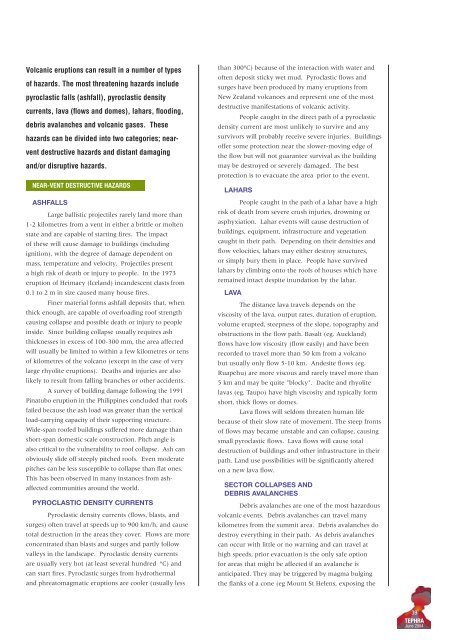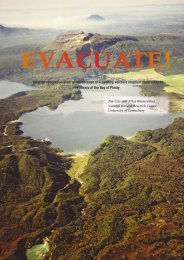Volcanoes - Ministry of Civil Defence and Emergency Management
Volcanoes - Ministry of Civil Defence and Emergency Management
Volcanoes - Ministry of Civil Defence and Emergency Management
You also want an ePaper? Increase the reach of your titles
YUMPU automatically turns print PDFs into web optimized ePapers that Google loves.
Volcanic eruptions can result in a number <strong>of</strong> types<br />
<strong>of</strong> hazards. The most threatening hazards include<br />
pyroclastic falls (ashfall), pyroclastic density<br />
currents, lava (flows <strong>and</strong> domes), lahars, flooding,<br />
debris avalanches <strong>and</strong> volcanic gases. These<br />
hazards can be divided into two categories; nearvent<br />
destructive hazards <strong>and</strong> distant damaging<br />
<strong>and</strong>/or disruptive hazards.<br />
NEAR-VENT DESTRUCTIVE HAZARDS<br />
ASHFALLS<br />
Large ballistic projectiles rarely l<strong>and</strong> more than<br />
1-2 kilometres from a vent in either a brittle or molten<br />
state <strong>and</strong> are capable <strong>of</strong> starting fires. The impact<br />
<strong>of</strong> these will cause damage to buildings (including<br />
ignition), with the degree <strong>of</strong> damage dependent on<br />
mass, temperature <strong>and</strong> velocity. Projectiles present<br />
a high risk <strong>of</strong> death or injury to people. In the 1973<br />
eruption <strong>of</strong> Heimaey (Icel<strong>and</strong>) inc<strong>and</strong>escent clasts from<br />
0.1 to 2 m in size caused many house fires.<br />
Finer material forms ashfall deposits that, when<br />
thick enough, are capable <strong>of</strong> overloading ro<strong>of</strong> strength<br />
causing collapse <strong>and</strong> possible death or injury to people<br />
inside. Since building collapse usually requires ash<br />
thicknesses in excess <strong>of</strong> 100-300 mm, the area affected<br />
will usually be limited to within a few kilometres or tens<br />
<strong>of</strong> kilometres <strong>of</strong> the volcano (except in the case <strong>of</strong> very<br />
large rhyolite eruptions). Deaths <strong>and</strong> injuries are also<br />
likely to result from falling branches or other accidents.<br />
A survey <strong>of</strong> building damage following the 1991<br />
Pinatubo eruption in the Philippines concluded that ro<strong>of</strong>s<br />
failed because the ash load was greater than the vertical<br />
load-carrying capacity <strong>of</strong> their supporting structure.<br />
Wide-span ro<strong>of</strong>ed buildings suffered more damage than<br />
short-span domestic scale construction. Pitch angle is<br />
also critical to the vulnerability to ro<strong>of</strong> collapse. Ash can<br />
obviously slide <strong>of</strong>f steeply pitched ro<strong>of</strong>s. Even moderate<br />
pitches can be less susceptible to collapse than flat ones.<br />
This has been observed in many instances from ashaffected<br />
communities around the world.<br />
PYROCLASTIC DENSITY CURRENTS<br />
Pyroclastic density currents (flows, blasts, <strong>and</strong><br />
surges) <strong>of</strong>ten travel at speeds up to 900 km/h, <strong>and</strong> cause<br />
total destruction in the areas they cover. Flows are more<br />
concentrated than blasts <strong>and</strong> surges <strong>and</strong> partly follow<br />
valleys in the l<strong>and</strong>scape. Pyroclastic density currents<br />
are usually very hot (at least several hundred ºC) <strong>and</strong><br />
can start fires. Pyroclastic surges from hydrothermal<br />
<strong>and</strong> phreatomagmatic eruptions are cooler (usually less<br />
than 300ºC) because <strong>of</strong> the interaction with water <strong>and</strong><br />
<strong>of</strong>ten deposit sticky wet mud. Pyroclastic flows <strong>and</strong><br />
surges have been produced by many eruptions from<br />
New Zeal<strong>and</strong> volcanoes <strong>and</strong> represent one <strong>of</strong> the most<br />
destructive manifestations <strong>of</strong> volcanic activity.<br />
People caught in the direct path <strong>of</strong> a pyroclastic<br />
density current are most unlikely to survive <strong>and</strong> any<br />
survivors will probably receive severe injuries. Buildings<br />
<strong>of</strong>fer some protection near the slower-moving edge <strong>of</strong><br />
the flow but will not guarantee survival as the building<br />
may be destroyed or severely damaged. The best<br />
protection is to evacuate the area prior to the event.<br />
LAHARS<br />
People caught in the path <strong>of</strong> a lahar have a high<br />
risk <strong>of</strong> death from severe crush injuries, drowning or<br />
asphyxiation. Lahar events will cause destruction <strong>of</strong><br />
buildings, equipment, infrastructure <strong>and</strong> vegetation<br />
caught in their path. Depending on their densities <strong>and</strong><br />
flow velocities, lahars may either destroy structures,<br />
or simply bury them in place. People have survived<br />
lahars by climbing onto the ro<strong>of</strong>s <strong>of</strong> houses which have<br />
remained intact despite inundation by the lahar.<br />
LAVA<br />
The distance lava travels depends on the<br />
viscosity <strong>of</strong> the lava, output rates, duration <strong>of</strong> eruption,<br />
volume erupted, steepness <strong>of</strong> the slope, topography <strong>and</strong><br />
obstructions in the flow path. Basalt (eg. Auckl<strong>and</strong>)<br />
flows have low viscosity (flow easily) <strong>and</strong> have been<br />
recorded to travel more than 50 km from a volcano<br />
but usually only flow 5-10 km. Andesite flows (eg.<br />
Ruapehu) are more viscous <strong>and</strong> rarely travel more than<br />
5 km <strong>and</strong> may be quite "blocky". Dacite <strong>and</strong> rhyolite<br />
lavas (eg. Taupo) have high viscosity <strong>and</strong> typically form<br />
short, thick flows or domes.<br />
Lava flows will seldom threaten human life<br />
because <strong>of</strong> their slow rate <strong>of</strong> movement. The steep fronts<br />
<strong>of</strong> flows may became unstable <strong>and</strong> can collapse, causing<br />
small pyroclastic flows. Lava flows will cause total<br />
destruction <strong>of</strong> buildings <strong>and</strong> other infrastructure in their<br />
path. L<strong>and</strong> use possibilities will be significantly altered<br />
on a new lava flow.<br />
SECTOR COLLAPSES AND<br />
DEBRIS AVALANCHES<br />
Debris avalanches are one <strong>of</strong> the most hazardous<br />
volcanic events. Debris avalanches can travel many<br />
kilometres from the summit area. Debris avalanches do<br />
destroy everything in their path. As debris avalanches<br />
can occur with little or no warning <strong>and</strong> can travel at<br />
high speeds, prior evacuation is the only safe option<br />
for areas that might be affected if an avalanche is<br />
anticipated. They may be triggered by magma bulging<br />
the flanks <strong>of</strong> a cone (eg Mount St Helens, exposing the<br />
39<br />
TEPHRA<br />
June 2004

















